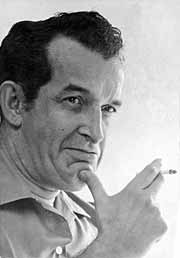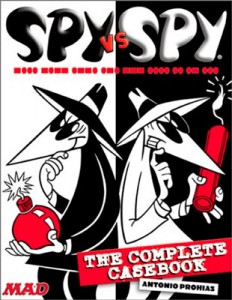 Antonio Prohías (January 17, 1921 – February 24, 1998), born in Cienfuegos, Cuba, was a cartoonist most famous as the creator of the comic strip Spy vs. Spy for Mad magazine.
Antonio Prohías (January 17, 1921 – February 24, 1998), born in Cienfuegos, Cuba, was a cartoonist most famous as the creator of the comic strip Spy vs. Spy for Mad magazine.
In 1946, Prohías was given the Juan Gualberto Gómez award, recognizing him as the foremost cartoonist in Cuba. By the late 1940s, Prohías had begun working at El Mundo, the most important newspaper in Cuba at the time. In January 1959, Prohías was the president of the Cuban Cartoonists Association; after Fidel Castro seized power, he personally honored the cartoonist for his anti-Batista political cartoons. But Prohías soon soured on Castro’s actions of muzzling the press. When he drew cartoons to this effect, he was dismissed by his newspapers, which had been taken over by Fidel Castro’s government. With his professional career in limbo, Prohías left Cuba for New York on May 1, 1960, working in a garment factory by day and building a cartoon portfolio for Mad by night. Ten weeks later, he had sold his first work to Mad.
The Mad staff occasionally took group vacations, traveling en masse to other countries. Prohías took part in these vacations when possible, but as a Cuban exile, he had trouble gaining admission into some countries, and at the airport before a vacation to Italy, an airport official said, “You can leave if you want, but you can never come back.” After the group returned, he presented a drawing to MAD publisher William M. Gaines, which was of him, with the Spies at his feet, letting his heart fly over the angry airport officials to the rest of the MAD gang, with a note at the bottom which, when translated, reads: “Mr. Gaines, my heart will always travel with you.”
Although he is most famous for Spy vs. Spy, the majority of his comic strips, such as El Hombre Siniestro, La Mujer Siniestra, and Tovarich, were published mostly or only in Cuba. Altogether, only about 20 of his roughly 270 contributions to Mad were of anything other than the spy series. As a result, most of the available information on this other work comes from the Spy Vs Spy Complete Casebook (Watson-Guptill, 2001) and the Spy vs. Spy Omnibus (DC Comics, 2011).
He died of cancer at age of 77 and is buried in Woodlawn Park Cemetery and Mausoleum (now Caballero Rivero Woodlawn North Park Cemetery and Mausoleum) in Miami, Florida.
Main article: Spy vs. Spy
El Hombre Siniestro: (The Sinister Man) wore a wide-brimmed hat and overcoat and had a long pointed nose, becoming the prototype for the Spies. His description from the Spy Vs Spy Complete Casebook says it best: “A dark and dastardly character, El Hombre Siniestro thought nothing of chopping the tails off of dogs, or even the legs off of little girls. . . he was born out of the national psychosis of the Cuban people.” At the time right after Castro rose to power, there was a pronounced feeling of fatality and sinisterness in Cuba, and Prohías depicted this through his twisted El Hombre Siniestro strip. He and La Mujer Siniestra can be easily compared to the Spies—although, instead of fighting against a set rival, they simply do horrible things to anyone they can find. El Hombre Siniestro debuted in Bohemia in 1956, although in later years Prohías created new strips for Zig-Zag Libre after he moved to Miami.
La Mujer Siniestra: (The Sinister Woman) Like her counterpart, La Mujer Siniestra is about the titular character causing misery for everyone else. However, unlike El Hombre Siniestro’s mostly unrelated crimes, many of her strips involve either her attempt to find love (like, for example, cuckolding someone else’s lover) or to ruin other women.
Tovarich: Tovarishch is Russian for “comrade,” and so Tovarich was meant to be both a representation of the Communist Soviet government and of Fidel Castro. He is a corrupt Soviet dictator meant to parody Fidel. However, since Castro had not yet announced he was a Communist, nobody could complain about the comic. Since the setting was Russia and not Cuba, it could not be explicitly found as criticism. When his Communist colleagues complained, he would reply, “What? What’s wrong with it? It’s not about Cuba, it’s about Russia.” Tovarich’s appearance changed through the years; originally he wore a military cap with a star and had longer hair, but in the “funeral for Agapito” picture in the Complete Casebook, he wears a typical Russian ushanka (round rabbit fur hat) with a hammer and sickle on it. Tovarich first appeared in Prensa Libre in 1959, with a sampling of strips shown in the “Nyets to You Department” in MAD #68 of January 1962.
http://youtu.be/MD8GyokdALs
Like the Sinister Man and Woman, he was usually up to nasty tricks and getting away with them: in one strip, drawn at the height of the Cold War, he offers the hand of friendship to Uncle Sam; Uncle Sam is delighted and takes it, unaware that he is shaking the hand of a dummy while the real Tovarich is literally about to stab him in the back. Another such cartoon showed the materialism of the Politburo while denouncing the materialism of everyone else and preventing native people from acquiring wealth: A man is envisioning himself driving a luxury car, to which Tovarich dunks his head in ice water which the man emerges comatose and now only thinking of the hammer and sickle, supposedly now an obedient Communist who knows better than to think of acquiring wealth for himself. The man is then ordered to be a driver, where he is then shown chaffuering Tovarich in a luxury car, who is smugly smoking a cigar.
The Diplomat: An extremely minor character, but noteworthy for the fact that he had his own small feature of comic strips in MAD’s Big Book of Spy vs Spy Capers and Other Surprises (Warner Books, 1982) and appeared in the MADtv “Spy vs. Spy” short, “Defection”. He also appeared in the Fall 1970 Special, in a group of strips that might be said to bear a slight resemblance to Otto Soglow’s more benign The Little King. He wears a waistcoat, black jacket with coattails, a medal and a top hat, and also sports a long, pointed nose somewhat similar to that of the Spies.
Erizo: A character who appears in the “funeral” picture in the Complete Casebook, although nothing about him or his comic is explained. He debuted in the magazine Carteles in 1948.
Oveja Negra: Also known as Black Sheep. A young boy wearing a propeller beanie, T-shirt and shorts. He appears in some of the artwork for the Complete Casebook, including the “funeral” picture. (It’s worth noting that, in the aforementioned funeral picture, Oveja Negra is the only one who appears to be mourning.) He debuted in Informacion in 1949.
Anti-Communist and Anti-Castro cartoons: Featured in The Complete Spy vs. Spy Casebook, shows arguably Prohías’ most serious cartoons, such as depicting Castro as a mermaid singing a siren song to lure sailors to their deaths, or a skeleton having difficulty eating meals with the caption “Gentlemen, it is very difficult to eat with a hammer and sickle!”
Agencies/Various/Wiki/InternetPhotos/www.thecubanhistory.com
The Cuban History, Hollywood.
Arnoldo Varona, Editor.



 Antonio Prohias, cartoonist, creator of Spy vs. Spy (Mad Magazine). (born Cienfuegos)
Antonio Prohias, cartoonist, creator of Spy vs. Spy (Mad Magazine). (born Cienfuegos)